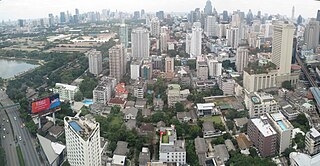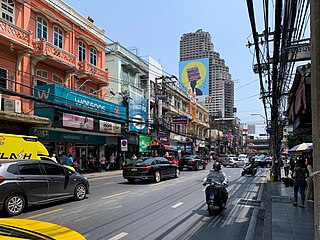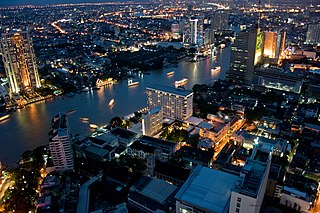
Bang Rak is one of the fifty districts (khet) of Bangkok, Thailand. It lies on the eastern bank of the Chao Phraya River, beyond Khlong Phadung Krung Kasem, which marked the old city boundary. Originating from riverside settlements dating from before the city's foundation, Bang Rak grew inland as new roads and canals were constructed through the area during the second half of the nineteenth century and the early twentieth, attracting communities of expatriates and developing into a major commercial district.

Phra Nakhon is one of the 50 districts (khet) of Bangkok, Thailand. It is the central district of Bangkok, including Rattanakosin Island. Neighboring districts are, from the north, clockwise: Dusit, Pom Prap Sattru Phai, Samphanthawong, and across the Chao Phraya River, Thon Buri, Bangkok Yai, Bangkok Noi, and Bang Phlat.

Samphanthawong ) is one of the 50 districts (khet) of Bangkok, Thailand. Regarded as Bangkok's Chinatown, it is the smallest district by area in Thailand. Neighbouring districts are Pom Prap Sattru Phai, Bang Rak, Khlong San, and Phra Nakhon.

Khlong Toei is a district in central Bangkok, long known for its slum. It is bordered by the Chao Phraya River and contains major port facilities. It is also the site of a major market, the Khlong Toei Market.

Yaowarat Road in Samphanthawong District is the main artery of Bangkok's Chinatown. Modern Chinatown now covers a large area around Yaowarat and Charoen Krung Road. It has been the main centre for trading by the Chinese community since they moved from their old site some 200 years ago to make way for the construction of Wat Phra Kaew, the Grand Palace. Nearby is the Phahurat or Little India. The area is bordered by the Chao Phraya River from the west to the south. Yaowarat Road is well known for its variety of foodstuffs, and at night turns into a large "food street" that draws tourists and locals from all over the city.

Bang Kho Laem is one of the 50 districts (khet) of Bangkok, Thailand. The incumbent district officer is Samita Xanthavanij. The district is bounded by Sathon, Yannawa, and across the Chao Phraya River, Rat Burana, Thon Buri and Khlong San districts.

Charoen Krung Road is a major road in Bangkok and the first in Thailand to be built using modern construction methods. Built during 1862–1864 in the reign of King Mongkut, it runs from the old city centre in Rattanakosin Island, passes through Bangkok's Chinatown, continues into Bang Rak district, where it formerly served the community of European expatriates, and ends in Bang Kho Laem. Construction of the road marked a major change in Bangkok's urban development, with the major mode of transport shifting from water to land. Charoen Krung Road was Bangkok's main street up to the early 20th century, but later declined in prominence. It is still home to many historic buildings and neighbourhoods, which are beset by changes as extension of the underground MRT is poised to drive new development.

Bangkok, Thailand, has an extensive water transport system serving passengers crossing or travelling along the Chao Phraya River as well as certain canals.
Bangkok, the capital of Thailand, is one of the world's top tourist destination cities. Each year, approximately 22.7 million international visitors arrive in Bangkok. MasterCard ranked Bangkok as the world's top destination city, with 15.98 million projected visitors in 2013. It topped the MasterCard Global Destinations Cities Index as the most visited city in the world in 2012, 2013, 2016, 2017 and 2018. The city is ranked fourth in cross-border spending, with 14.3 billion dollars projected for 2013, after New York, London and Paris. Euromonitor International ranked Bangkok sixth in its Top City Destinations Ranking for 2011. Bangkok has also been named "World's Best City" by Travel + Leisure magazine's survey of its readers for four consecutive years since 2010.

Bangkok's Chinatown is one of the largest Chinatowns in the world. It was founded in 1782 when the city was established as the capital of the Rattanakosin Kingdom, and served as the home of the mainly Teochew immigrant Chinese population, who soon became the city's dominant ethnic group. Originally centred around Sampheng, the core of Chinatown now lies along Yaowarat Road, which serves as its main artery and sometimes lends its name to the entire area, which is often referred to as Yaowarat. Chinatown's entire area roughly coincides with Samphanthawong District, and includes neighbourhoods such as Song Wat and Talat Noi along the Chao Phraya River, and Charoen Chai, Khlong Thom and Nakhon Khasem along Charoen Krung Road.

The Gold Line is an automated people mover line, part of Bangkok's rapid transit system. The line is 1.8 km (1.1 mi) long, consisting of 3 stations, and was opened by Thai Prime Minister Prayut Chan-o-cha on 16 December 2020. It primarily serves as a feeder line between the BTS Silom line and Iconsiam shopping center. The line will be extended 1 km (0.62 mi) along Somdet Chao Phraya road to connect with the future MRT Purple Line southern extension. When completed, it will connect Krung Thon Buri BTS station with Prajadhipok Road in Thon Buri District for a total distance of 2.68 km (1.67 mi).

Captain Bush Lane, now officially known as Soi Charoen Krung 30, is a side-street branching off Charoen Krung Road in Bang Rak District of Bangkok, Thailand. It was home to several members of Bangkok's early European expatriate community during the turn of the 19th–20th centuries, including Captain John Bush, an influential English sea captain after whom the street is named.

Ratchawong Road is a road in Bangkok, Thailand. It is located in the area of Bangkok's Chinatown, or popularly known in Thai as Yaowarat.

Surawong Road is a road in the Bang Rak District of Bangkok, Thailand, linking Charoen Krung Road to Rama IV and forming the boundary between Suriyawong and Si Lom subdistricts. It was built at the end of the 19th century during Bangkok's period of expansion following the country's opening up to the West, and was home to many leading businesses, upper-class families, and members of the expatriate community. It was known as a Western-style nightlife entertainment district during the 1920s, and was—and still is—home to many leading hotels. The road grew as a business district along with the nearby Si Lom Road during the mid-20th century, but lagged behind in development toward the end of the century due to its limited traffic capacity. Today, it is still home to several historic landmarks, as well as many well-known restaurants.

Chan Road, also known as Trok Chan, is a road and neighbourhood in Bangkok. It's a separate from Nang Linchi road in the area of Thung Maha Mek sub-district, Sathon district and runs through Chan - Naradhiwas intersection where it cuts across Naradhiwas Rajanagarindra road. In this phase, it also acts as a line between Sathon district's Thung Wat Don and Yan Nawa district's Chong Nonsi sub-district, then through two more intersections were Tai Duan Chan junction and Sathu - Chan junction as far as end at Trok Chan junction, where it combined with Charoen Krung road in the area of Wat Phraya Krai sub-district, Bang Kho Laem district, total distance is 7.0 km. At the end of the road on Charoen Krung side is close to two historic sites are Asiatique The Riverfront, originally, it was the location of the Danish maritime navigation company East Asiatic Company and Protestant Cemetery, include another place of education is Shrewsbury International School.

Wat Phraya Krai is one of three khwaeng (sub-district) of Bang Kho Laem district, Bangkok. It has a total area of 2.300 km2 west side along Chao Phraya river and in late 2017, it had a total population of 26,681 people.

The East Asiatic Building is a historic building in Bangkok's Bang Rak District. It sits on the eastern bank of the Chao Phraya River, opposite the Oriental Hotel on Soi Charoen Krung 40 and adjacent to the Catholic Mission and Assumption Cathedral. The building was built c. 1900 in Renaissance Revival style to designs by Annibale Rigotti, and served as the headquarters of the East Asiatic Company (Thailand) until 1995, receiving the ASA Architectural Conservation Award in 1984. In 2023, Asset World Corporation announced plans to renovate the building into a hotel under the Plaza Athénée brand, in partnership with Nobu Hospitality.

Bang Rak is a khwaeng (subdistrict) and historic neighbourhood in Bangkok's Bang Rak District. It lies between the Chao Phraya River and Charoen Krung Road, and was home to communities of European expatriates who settled in the area mostly during the second half of the 19th century as Siam opened up to the West. Among them were the Portuguese, French and British, whose embassies occupied extensive grounds in the area, Danes who founded shipping companies as well as the historic Oriental Hotel, and Catholic missionaries who established some of the first schools in the country on the grounds surrounding Assumption Cathedral.

The Embassy of France in Bangkok is the chief diplomatic mission of France in Thailand, and one of the oldest in the country. It was established as a consulate in its current location on the Chao Phraya River off Charoen Krung Road in Bangkok's Bang Rak District in 1857, following the signing of the Treaty of Friendship and Commerce which re-established diplomatic relations between the two countries the previous year. The mission was elevated to a legation in 1892 and an embassy in 1949, and supports the ambassador in promoting political, economic and cultural ties between the two countries.






























